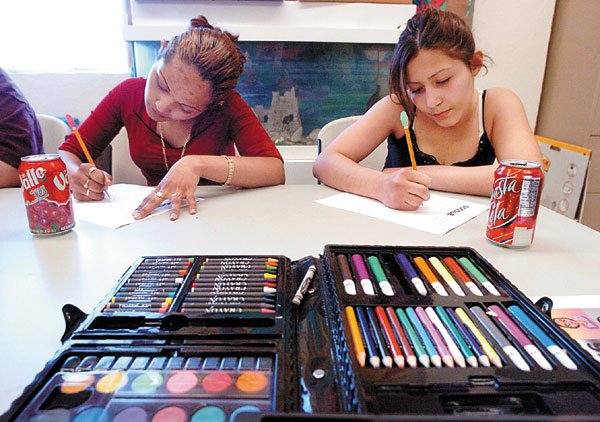Teens use drawing comics as a way to stay clear of gangs,
drugs
Eyes locked on the page, 13-year-old Pedro Gaeta conjures up a bird out of graphite, gently stippling one long, fabulous wing with his pencil. He is silent. All of them are, the six teens who sit hunched over their papers, neon erasers hovering like Technicolor flies as they labor at their drawings, stopping only for quick sips of Shasta cola. Two Styrofoam bowls of Doritos and Cheetos sit untouched in the white-walled room at the Gilroy Youth Center, where the teens doodle diligently under a crepe-paper sun.
“In the beginning it was crazy, just talking, talking, talking,” said Orlando Salcedo, over the strains of Spanish-language soft rock. Dressed all in black, with a ponytail and a goatee, he cuts the figure of a brooding artist – or he would, if he weren’t so warm. “Now they get in here, and they just – go.”
Tuesdays and Thursdays, as the clock nears 5:30pm, they gather, asking, “Is the class starting now? Now – is it ready?” Salcedo says. They seat themselves with their instruction packets, labeled with spaces for their names and the date over a wide blank frontier, to fill as they wish. Their first assignment: Doodle.
Since September, Salcedo has held his low-key art class here, coaching teens in contour shading, cartoon scale and freeing the imagination. He’s dubbed his students “the M-6”: ‘M’ for the Mexican American Community Service Agency, which snagged the funds to support the free class, and ‘6’ for the six rain-or-shine students who attend. Often, the class outgrows its name, with a dozen teens crowding the room, elbowing each other as they sketch.
That’s fine with Salcedo. He’s under pressure to get 50 teens to his program by summer, when MACSA reapplies for the funding. Each week, he takes the names of the kids who attend. When a teen shows up twice, Salcedo takes a photo and prints up a stylized nameplate, almost like a trading card, to post at the Youth Center. Cartoon doppelgangers of the teens spangle the door, like a roster of a younger, hipper Justice League.
To some, it might seem frivolous: A bunch of kids drawing comics. In an area riddled with drugs, crime and disappointment, why teach kids to draw comics?
Salcedo knows better. If it wasn’t for comics, he said, he’d probably be in jail.
A Latino kid growing up in east Gilroy at the bloody climax of the ’90s gang clashes, Salcedo might have slipped into the sordid war of north versus south. Even at age 10, he was a trouble-maker, he recalls. But one day, he idly drew a comic – Mickey Mouse dressed up as Robin Hood – and his fourth-grade teacher pinned it up on the wall, an honor he had never known.
“It stayed there almost a month,” he remembered. “I just thought, ‘Wow.’ ”
After that he was hooked, skipping lunch to draw computerized sketches or make sculptures. Outside school, he furtively read comic books at the 7-Eleven, comics he couldn’t afford to buy: Superman, Batman, Spiderman and Wolverine. Superheroes. Men with power.
“Every time I was mad, I’d draw myself. I drew other people. I could change the story,” Salcedo said. “It was like therapy, like I could take the problems out of my body.”
His students echo his words. Desiree Villescaz, 13, keeps an artist’s journal. When she’s angry, she draws flames. When she’s in love, she draws hearts. When problems erupt with friends, she spins them into comic-book narratives, and shows them to her younger brother.
“When I get upset, when something happens, I go to my room, turn on my music, and start working,” added Eric, 14, who asked to be identified only by his first name. He admires Japanese manga comics, and draws with thick, defiant strokes. Under Salcedo’s guidance, he’s trying to master realism, too. “I draw out my feelings.”
Often, teens present their comics to Salcedo for critique, a request he refuses.
“That’s not what I do,” he said. “It’s like training. I tell them, ‘Just keep going.’ ”
Through their comics, Salcedo reads their emotions, what’s going on under the everyday teenage duck-and-cover. Unless their art reveals serious danger, to themselves or others, he doesn’t intercede. But in the square panels where fantasy and reality mingle, he sees their frustrations, their fears, and their triumphs.
“Some kids don’t know how to express themselves by talking,” Salcedo said. “If they can’t say it, they write it, or they draw it. And if they can’t do that? They’ll act out.”
He sighs. “They’re like little fish, going back and forth. They don’t know which way to go.”
sugsubhed: Art programs often ignored or erased
Few programs offer what Salcedo’s does. Many of his students come from El Portal Leadership Academy, which has no art classes. As budget cuts pare down youth programming and school services, the arts are usually first to go under the knife. Even with MACSA’s funding, Salcedo still pays for supplies: a rainbow of pastels and markers, reams of paper. He brings in his graphite shader – a paper nib to blend pencil – and his students pass it back and forth, delicately, like an alien and treasured thing.
“Artists have better opportunities than they’ve had in a long, long time,” said Bob Peacock, a Gavilan College professor who once taught Salcedo, and helped him create his class. “It’s just a matter of how bad you want to do it, and if you’re willing to put yourself to the grindstone.” Of the M-6, he said, “They’re good kids. They just need an opportunity to see what’s outside of Gilroy, and to see what they can do.”
Through field trips to art galleries and museums, Salcedo wants to open those horizons. The M-6 are planning six murals, to grace the walls of youth centers across the county. The students will design and execute the murals, and teach their craft to teens at other county centers. Their biggest project, however, is a comic book, compiled from their own drawings, that takes on topics such as relationships, sexuality and gender, family, drugs, peer pressure, alcohol and teen pregnancy. Between panels, Salcedo wants to run ads for local clinics and hotlines, to connect teens with the services they need. He plans to distribute the comic book to clinics across South County.
Already, the teens’ drawings have progressed, evolving from tentative scribblings to confident, sometimes striking images. Rows of manila folders chart their work. Lilia Rodriguez’ first drawing, a storyboard of stick figures, gives way to a fanciful scene of a wide-eyed girl alongside a tree. It looks almost like a Disney prototype. Eric holds up a cartoon head for Salcedo to examine.
“Awesome,” declares Salcedo. “Now keep going.”













